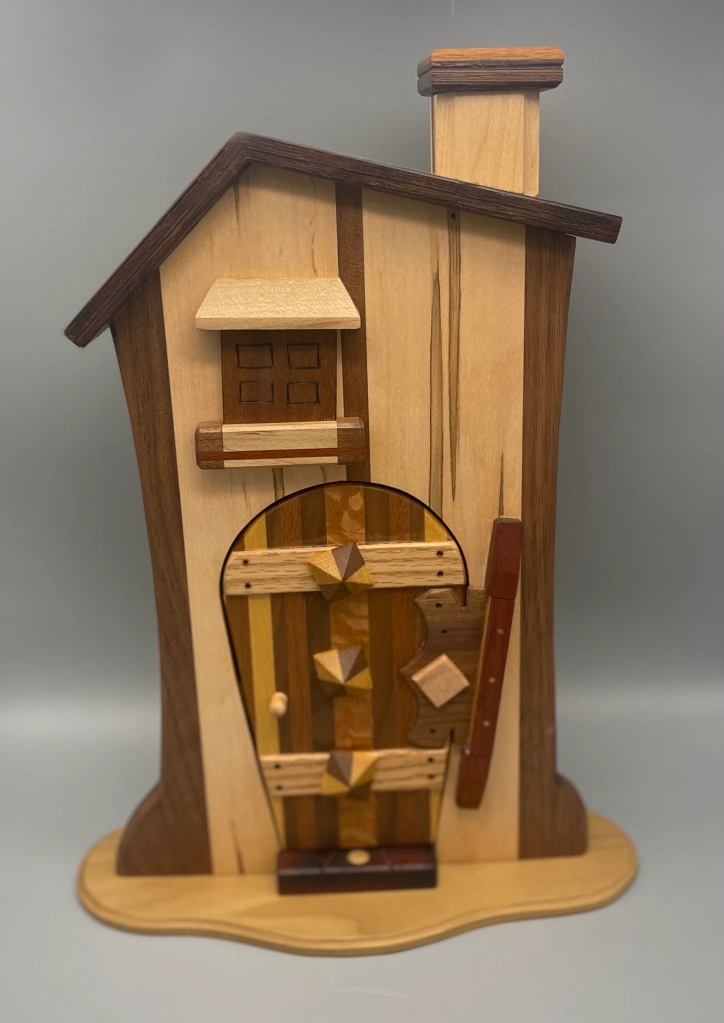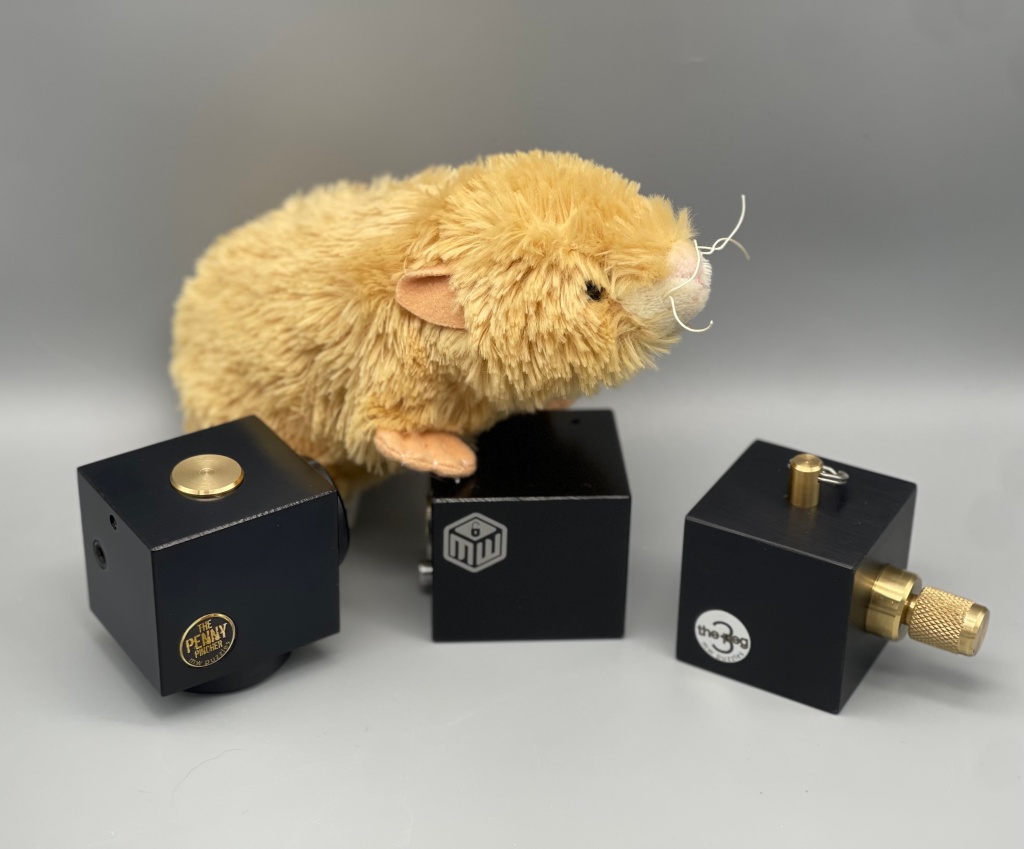Well it is that time of year once again…. past it really but I’ve been slow to get my ducks in a row and sit down and provide what I hope is a helpful annual post: an overview of last year’s Karakuri Holiday Boxes! I’ve done similar posts for 2020, 2021, and 2022 and have heard they have come in handy for those who missed out on one, some, or all of the year’s boxes, so off we go yet again down Santa Sinatra’s rabbit hole of fun!

Akio Kamei – Spinning Die
80×80×80mm; walnut & magnolia

Kamei’s box appears quite similar to another Karakuri box, Dice, which has a rather amusing solution that is perhaps a bit of a classic, the kind of thematic solution that you expect from KCG. Spinning Die is considerably more complex – I am not sure I would have ever solved it on my own without some help tbh. The solution complicates the theme so that it is more thematic but less intuitive, if that makes any sense at all (as if that’s ever been a requirement for these write-ups). Its complication makes for the trickiest of the year although perhaps not as high on the fun factor as some other, simpler releases. As always, it just depends on your priorities – regardless, it looks so nice next to its KCG cousin.
Daiki Arimura – Nanomedashi
83×50×76mm; cherry, walnut & magnolia
Nanomedashi’s simplicity and elegance makes it one of my favorites for the year, in some ways the opposite of Die: simple but fun. It looks like a small file cabinet (readers may know of my office-themed puzzle fetish) with matching drawers on either side. It was one of the first I was able to solve and required no help (I’m a big boy!) so don’t go for it expecting overly complicated mechanisms. It is the one I have probably re-solved the most, appreciating the way it plays on our assumptions with an opening move that has me grinning every time.

Hiroshi Iwahara – Box of Branch and Loophole
84×84×40mm; walnut, magnolia, padoauk & keyaki (zelkova)

Iwahara’s box is a fun twist on a more traditional box in some ways while still managing to be wholly original. You can guess some of what you have to do but there will still be a struggle to get things to go your way, with moves “branch”ing off in unexpected sequences. Seasoned puzzlers will enjoy wandering around the box, getting lost and found while seeking the solution. I got lost many, many times and was happily surprised to learn that even after I thought I had finally solved it, more puzzling awaited.

You Kakuda – Thinking Bat
60×54×86mm; chanchin, magnolia, walnut & mizuki (dogwood)
Hold on, Toad wasn’t by Kakuda?! Well, so long as there was an animal involved… Bat starts off easily enough before doing nothing at all. I was stuck going in circles on this for quite some time before a deviously simple aha! hit me, bringing me that subtle twist on the puzzle’s mechanisms required to finally open it. A smart and re-solvable box, indeed.

Osamu Kasho – Toad
84×84×45mm; Japanese walnut, mizuki (dogwood) & magnolia

Another of this year’s favorites, Toad has a devilishly hidden step that eluded me for far longer than it probably should have. I played with it for quite some time before somewhat accidentally stumbling into a very well-hidden step that I almost didn’t even notice. Eventually I realized I had done something and was able to open the box. Fun to re-solve, it is a great example of how Karakuri boxes can mess with us.
Hideaki Kawashima – FS Cube
80×80×80mm; Japanese walnut, magnolia & cherry
Dude, FS Cube may take the cake this year – At first, I was pretty sure this puzzle was going to be a big letdown and was surprised when I eventually needed a big nudge to solve this one as it contains a step that is just oh so very, very clever. I want to say so many things about this mechanism but can’t find a way without letting slip at least some subtle spoiler; suffice it to say that when I finally figured out the central aha!, I laughed and still laugh when I re-solve it. It had me pondering how it was accomplished and surprised that I had not seen anything similar to it before.

Yasuaki Kikuchi – Clumsy Santa
66×66×110mm; chanchin, magnolia & maple

Another of my fav’s for the year, Clumsy Santa is the only holiday-themed box of 2023, unsurprising considering Kikuchi has brought us holiday-themed boxes for the last three years as well. This year we have an amusingly simple box with a well-hidden mechanism that is ever so fun to play with and re-solve. And like some previous years, you will find a nice surprise once solved!
Shou Sugimoto – Rattlesnake
119×70×53mm; Japanese walnut, magnolia, walnut, katsura & maple
Rattlesnake allows you to slither around rather freely, with a central mechanism that I would love to see uncovered, as it has me wondering how exactly Sugimoto accomplished it. Tricky and clicky this one has high fidget value with haptic feedback that is quite satisfying. I will admit I needed to check the solution to finally solve it; I knew what to do but could not get it right without some clearer guidance than the puzzle gives. I imagine many a puzzler might cringe at my casual cravenness but whatevs bruh.

And that’s our holiday boxes for 2023! Puzzlers will note that KCG has changed things up a bit for 2024 – now members must subscribe to their makers early (as in it is now too late for almost every maker) for fear of selling out. My stomach still drops at the fact that I was too late for several makers due to an in-hindsight-stupid procrastinationly ridden lack of puzzling awareness that I’ve been around far too long to have made (yes, my stomach actually drops… I repeat: whatevs bruh). Ah well, there is always the resale market (cringe).
































































